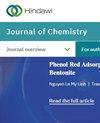Synthesis and Characterization of Grewia asiatica-Stabilized Silver Nanoparticle as a Selective Probe for Al+3 in Tap, Deionized, Industrial Waste Water and Human Blood Plasma
IF 2.6
4区 化学
Q2 CHEMISTRY, MULTIDISCIPLINARY
引用次数: 0
Abstract
Aluminum can be found in water and vegetables in the form of the trivalent ion (Al3+), which can potentially contaminate food and water. Overconsumption of aluminum can lead to serious health problems in humans. Therefore, there is a need for an economical and simple procedure to detect the presence of aluminum. In this study, we synthesized a conjugate of Grewia asiatica extract with silver nanoparticles. The nanoparticle-stabilized fruit extract of Grewia asiatica was found to be an extremely selective sensor of Al3+ in tap water, DI water, industrial wastewater, and human blood plasma. We characterized the Grewia asiatica-conjugated silver nanoparticles (GA-AgNPs) using UV-visible, SEM, and AFM techniques and found that they were stable in an extensive pH range and different electrolyte concentrations up to 10 M NaCl. The GA-AgNPs were circular in shape with typical particle sizes of 65–97 nm. We inspected the photo physical properties of GA-AgNPs concerning metallic ions using UV-visible spectroscopy and found that they were highly selective for Al3+ ions, with no interfering ions detected in competitive experimentation. The absorption intensity of GA-AgNPs was directly related to Al3+ concentration over a wide range of concentrations (6.25–500 μM). Jobs plot experiment displayed 1 : 1 binding stoichiometry between GA-AgNPs, and Al3+. Additionally, GA-AgNPs were effectively utilized for the recognition of Al3+ in laboratory tap water, DI water, industrial wastewater, and human blood plasma.自来水、去离子水、工业废水和人体血浆中作为 Al+3 选择性探针的 Grewia asiatica 稳定银纳米粒子的合成与表征
铝以三价离子(Al3+)的形式存在于水和蔬菜中,有可能污染食物和水。过量摄入铝会导致严重的人体健康问题。因此,需要一种经济、简单的方法来检测铝的存在。在这项研究中,我们合成了一种银纳米粒子与豚草提取物的共轭物。研究发现,纳米颗粒稳定的芒果提取物对自来水、去离子水、工业废水和人体血浆中的 Al3+ 具有极高的选择性。我们利用紫外可见光、扫描电镜和原子力显微镜技术对天南星果实共轭银纳米粒子(GA-AgNPs)进行了表征,发现它们在广泛的 pH 值范围和高达 10 M NaCl 的不同电解质浓度下都很稳定。GA-AgNPs 呈圆形,典型粒径为 65-97 nm。我们利用紫外可见光谱检测了 GA-AgNPs 有关金属离子的光物理性质,发现它们对 Al3+ 离子具有高度选择性,在竞争性实验中未检测到干扰离子。在很宽的浓度范围(6.25-500 μM)内,GA-AgNPs 的吸收强度与 Al3+ 浓度直接相关。乔布斯图实验显示,GA-AgNPs 与 Al3+ 的结合比例为 1 :1 的结合比例。此外,GA-AgNPs 还能有效识别实验室自来水、去离子水、工业废水和人体血浆中的 Al3+。
本文章由计算机程序翻译,如有差异,请以英文原文为准。
求助全文
约1分钟内获得全文
求助全文
来源期刊

Journal of Chemistry
CHEMISTRY, MULTIDISCIPLINARY-
CiteScore
5.90
自引率
3.30%
发文量
345
审稿时长
16 weeks
期刊介绍:
Journal of Chemistry is a peer-reviewed, Open Access journal that publishes original research articles as well as review articles in all areas of chemistry.
 求助内容:
求助内容: 应助结果提醒方式:
应助结果提醒方式:


